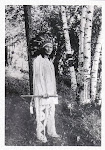Popular views of Eastman, such as in the HBO film "Bury My Heart at Wounded Knee," present him as a poster child for assimilation, a flat, inaccurate, diminished, and misleading portrayal of this larger-than-life historical figure. This is a loss that needs rectifying. Some of the passages or phrases in his written works and speeches, especially the early ones, bear the harsh imprint of condescending assimilation values. Taken in context, though, the passages often have a twist to them, demonstrating the tensions within him and the way he was using what he’d learned for his own Dakota agendas. Later in life his rallying cry became “Freedom and Self Determination for the Indian!” He spoke out for Indians who’d never be invited to the White House, who could not legally vote, who’d been colonized and imprisoned on reservations.
As with Obama, if the life of Eastman were told in fiction, it would not be believed. But in memoir, as in Indian Boyhood and From the Deep Woods to Civilization, his life captures one’s attention – how did he do it? What made him who he was? As a child, he survived the Dakota (Sioux) Conflict of 1862 and fled to Canada to be raised traditionally until the age of fourteen or fifteen, knowing no other language than Dakota. Then in American schools, he learned to read and write in his own tongue. He came to discern and negotiate the cultural differences in cosmic orientations, teaching and social practices, becoming facile and aware in his adapting. By thirty-two, he could read and write in English as well as in various foreign and classical languages, graduating from Boston University School of Medicine, selected by his classmates as the convocation speaker. In 1890, he was hailed nationally as the example of the perfect “educated” Indian.
However, by chance or destiny, Dr. Eastman was the physician at Pine Ridge Reservation when a Sioux party under a flag of truce was gunned down at nearby Wounded Knee Creek. Through a blizzard, he sought out and bound up the Lakota survivors, then used the press to alert the nation to the dishonorable massacre of women and children and to graft on the Pine Ridge Reservation. Government authorities rebuked him for “stirring up trouble” and pressured him to resign his post.
This became a pattern. He was promoted as the model Indian until he told the truth about the injustice and corruption he encountered. Then he was fired. In similar ways, he was admired by some Indian colleagues until he challenged reservation residents to give apathy, despair, and drink -- and later peyote -- to regain their traditional values, reclaim their outdoors fitness, rebuild their support societies, and use white education against oppression. Because of his fame and his stand against peyote, some Indians stuck him into the stereotyped category of an “apple”, red on the outside, white on the inside, a slur that may have injured him more than all the white slings of “savage.”
Like his father, Ohiyesa valued white education as the key arrow American Indians would need in their quivers to hunt out their futures. It was a door to a wider world containing art, music, and other cultures, and he wanted all Indian students to have the chance to experience the same thrills and broadness of opportunities he’d been fortunate enough to have, but he also wanted them to hold tightly to what made them who they were. Though he mourned what he and his people had lost, he did not mourn what he had gained. Some of his favorite compatriots long into his life were his Dartmouth classmates.
His focus, from youth on, was to be of use to his people, and through the course of his life, his definition of “his people” kept expanding, from the Dakota, to all Indian nations, to all Americans, to all the world’s peoples -- while never losing his heart for his own.
Trials of an Educated Indian
"I wish to contradict the popular misconception that an educated Indian will necessarily meet with strong prejudice among his own people, or will be educated out of sympathy with them. From their point of view, a particularly able or well-equipped man of their race is a public blessing, and all but public property. . . . Every complaint was brought before him, . . . and he was expected to expose and redress every wrong."
Charles Eastman (Ohiyesa), The Indian To-day
Saturday, July 25, 2009
Subscribe to:
Post Comments (Atom)





No comments:
Post a Comment